RegenOx® Excavation Application Treats Groundwater Contamination
80% TPH Concentration Reduction at California DoD Facility
Project Highlights
- Source removal and RegenOx® ISCO application reduce contamination levels to clean-up standards
- Horizontal piping network installed as contingency plan for additional remediation
- 80% reduction in groundwater concentrations observed

Project Summary
The project site is a former Department of Defense (DoD) fuel dispenser facility in Northern California where past corrective measures included AST/UST removal, soils excavation and groundwater monitoring. Sample results indicated continued elevated concentration levels of TPH-G, TPH-D and TPH-mo within a defined area near the former USTs. The treatment approach included additional excavation and in situ chemical oxidation (ISCO) application via RegenOx mixed into saturated zone. Quarterly sampling indicated an 80% reduction in groundwater concentration levels post treatment; which met the corrective action cleanup levels for TPH.
Remediation Approach
The selected contractor excavated, managed and disposed of impacted soils to depths of nine feet over the two defined treatment areas. RegenOx Part A (oxidizer) and Part B (silica gel activator solution) were placed in the saturated zone and mixed in with the excavator bucket to 3 feet below the excavation bottom. Prior to backfill and compaction, a horizontal piping network was installed to serve as a contingency plan in the event that any additional in situ and/or bioremediation remediation was required. Regenesis assisted the client with the horizontal piping network design which was incorporated into the bid specifications. This site area has been submitted for closure and with continued quarterly monitoring.
Technology Description
RegenOx is an advanced chemical oxidation technology that destroys contaminants through powerful, yet controlled chemical reactions and not through biological means. This product maximizes in situ performance while using a solid alkaline oxidant that employs a sodium percarbonate complex with a multi-part catalytic formula.

 Americas
Americas Europe
Europe Français
Français Deutsch
Deutsch Italiano
Italiano Español
Español



